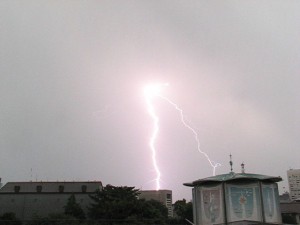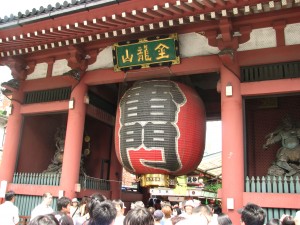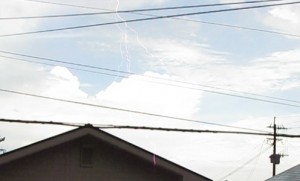Thunder and Lightning Posted by Marcel on Jul 31, 2012 in Uncategorized
Due to all the 雨 (あめ/rain) we had over the last 2ヶ月 (にかげつ/two months), I’ve thoroughly got 雷 (かみなり/lightning) on the brain. We don’t get 雷 *every* time 雨が降る (あめがふる/rain falls), but we still get it a lot. I personally love to sit at a 窓 (まど/window) with a cup of 紅茶 (こうちゃ/ black tea) and watch the 稲妻 (いなずま/lightning bolts) streak across the 空 (そら/sky), or at least listen to the rumble of the 雷 (lightning in general, but in this case used to describe thunder), but I’m apparently in a very small minority. Very few people around here seem to enjoy it like I do.
Two 神様 (かみさま/gods or spirits) in Japanese folklore that are often mentioned when the 雷 starts to roll are the 風の神様 (かぜのかみさま/god of wind), 風神 (ふうじん/Fuujin), and the 雷の神様 (かみなりのかみさま/god of thunder or lightning, 雷神 (らいじん/Raijin). A good place to see statues of these two are at the main gate at 雷門 (かみなりもん/Kaminari-mon) in 浅草 (あさくさ/Asakusa), 東京 (とうきょう/Tokyo), although they can be seen at many shrines all over 日本 (にっぽん/Japan). As they face each other on either side of the gate, it’s easy to imagine them working, creating the terrible storms that frequently blow through 日本.
If you ever try to take photos of 稲妻, like the one in this blog entry or a previous entry you’ll soon find out that 雷 is too fast for your shutter finger. Instead, take a ビデオ (video) of the 空! If you are lucky, after a few minutes you’ll have caught a few 稲妻. On your パソコン (computer), you can then use a video player like VLC to skip to the moments when there is a lightning bolt and pause the video. With many video players, you can can skip forwards and backwards frame by frame until you get a good shot, then save a screenshot of that frame. It sounds complicated, but after you do it once, it’ll only take a few seconds the next time. That’s how I gathered all my 稲妻 bolt pics!
Happy 雷 Hunting!

Build vocabulary, practice pronunciation, and more with Transparent Language Online. Available anytime, anywhere, on any device.







Comments:
Tim Upham:
Futsu-Nushu-no-Kami, is the god of lightning or war or fire. He is the general of Amaterasu or Supreme Sun Goddess. Amaterasu may be of Siberian origin, but not Futsu-Nushi-no-Kami. Because lightning never occurs in the Arctic, but in Japan where there is a mixture of hot and cold air. The shide is a zig zag paper streamer or haraegushi or lightning wand. It is similar to the Ainu inau or shaved willow branch. The inau are placed next to the hearth, to honor the Ainu deity, Kamuy Fuchi or goddess of the hearth. So the reference to the deity of lightning along with fire, obviously comes from Ainu origin, which also help shaped modern Shinto as the indigenous religion of Japan.
Japanese Learner:
Hi there
Actually, all these Japanese words are mostly only specific names or subjects, in this case religion. For these you have to learn it simply by hard to recognise, but at least I knew all the Japanese items before, so I learned nearly zero.
Furthermore you’re a language blog but your Hiraganaspelling is quite incorrect かぜにかみさま it should be rewritten without the particle に but の 風の神様.
At least it reminded myself when I visited Japan in 2011, I was at the same place like you and I have to agree, that the 浅草寺 (あさくさでら or センソウジ Hirgana is Japanese, Katakana is Sino-japanese) in 台東区 (タイトウク) is a wonderful place, which everyone ever visiting Tokyo, should see.
Marcel:
@Japanese Learner Oops, just a small typo (i is right next to o, after all). I get my wife to proofread my japanese, but she missed it too 😉
You are right that sometimes I use some difficult Kanji that people don’t learn right away, and in fact I myself can’t remember them all yet, so my wife helps me. Still, many of the words are vocabulary that a beginner should be learning (wind, rain, sky, etc…), even if they aren’t learning the Kanji yet. That’s why I add the hiragana as well. If you know the word, but not the kanji, then maybe the kanji will be interesting to see. If you know neither, then you can focus on the hiragana alone. If you know everything, then I tip my hat to you!